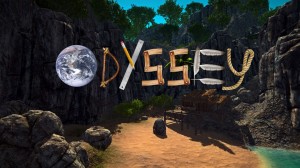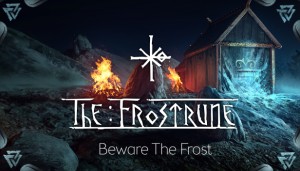Review for RiME

While open-world adventures through the crumbling ruins of ancient civilizations have largely belonged to the family of Myst-style puzzlers on PC, the PlayStation has quietly been responsible for a different kind of game. Titles like ICO and Journey have forsaken the graphically realistic, technology-intensive first-person designs of their computer-based brethren in favour of highly stylized third-person experiences with a more hands-on approach and even a greater element of danger. Fortunately, such games have begun migrating across platforms, with newer titles like ABZÛ releasing for both PC and consoles. Often requiring a degree of dexterity to succeed, these are not your granddaddy’s point-and-clicks, but their focus is clearly on exploration, environmental storytelling, and very personal narratives beneath their more action-oriented exteriors.
The latest exhibit for the console-driven adventure is RiME, a game about a young boy who washes up on the shore of an uninhabited island following a shipwreck. Its cel-shaded 3D artwork is gorgeous, and the gameplay is more substantial than many of its ilk, offering 7-8 hours of jumping, climbing… and yes, plenty of puzzle-solving as well. Its length does come at a cost, however, as the objectives start to feel repetitive even with a clever repackaging of familiar environments, and a story that will barely fill five minutes of your attention along the way. As initially mysterious and ultimately poignant as it may prove to be, the underlying narrative is so slight as to be practically non-existent as a motivation throughout, and feels like something of a cheat when all is revealed dramatically at the end. RiME is not a perfect adventure, then, but it’s certainly a welcome breath of fresh air for those looking for something a little different.
You might think the first order of business for a castaway would be survival, but our young unnamed protagonist awakens ready to hit the ground running – literally. That’s good, as this is a deceptively expansive island filled with the remains of what was clearly a once-mighty civilization to investigate. Of course, you might want to pause a moment before setting off, soaking in the beautiful sights of rocky outcroppings, lapping ocean waves, small waterfalls and fountains, plus an array of abandoned towers and temples adorned with bizarre sculptures. Listen, too, to the soothing ambient sounds befitting an island left to nature, and the orchestral soundtrack with its variety of lovely, often melancholy violin- and piano-heavy scores. Soon enough, you’ll even get to see the scenery transform before your eyes thanks to a stunning day/night cycle that shifts from cloudless blue noon to purple dusk to a veritable starburst in the night skies and then back again. Much of your time will be spent inside the manmade structures with their own architectural attractions, but it’s the outdoor landscapes that captivated me the most, particularly when other impressive weather elements factored in later on.
It isn’t immediately obvious what to do at first, but after a little aimless wandering you’ll discover that the island isn’t entirely uninhabited. Small furry animals scurry about here and there, one of which is a red fox that takes a particular interest in your affairs, forging ahead and barking (do foxes really sound like annoyingly yappy pet dogs?) for you to follow at key intervals. Actually, saying “key” is being overly charitable, as I often found the little critter AWOL whenever I needed it most, only to show up when there was really only one way to go.
Direction matters here, as RiME really isn’t as “open-world” as its layout suggests. True, you can freely explore the rugged terrain, and interiors often have hub areas with branching paths, but apart from a few “find X number of item” quests, in general you can only accomplish one goal at a time so you’re continually being funneled one way or another. Occasionally the game falls prey to the horrible tendency of being overly maze-like (especially, you know, that entire maze level in the dark), but typically it’s not that hard getting to where you want to go… so long as you know where that is. (Fox? Hey, fox! Dammit, ran off again!) The best games do a great job of leading you so subtly that you’re never sure you’re going the right away until suddenly you’re there. That happens frequently here, but sometimes not. Zig just once when you should zag in the wrong place, and you can waste a whole lot of time with no indication you’re on the wrong track.
What challenge there is in getting from place to place stems largely from the platforming, but the physical element is rarely very demanding. Either through keyboard/mouse or gamepad control (I preferred the latter), you’ll guide the young protagonist with one hand and the camera with the other, jumping where necessary and stopping to push, pull, or carry the odd interactive object like sliding blocks, switches, and energy orbs. Navigation is smooth, with lots of room to maneuver in most cases, and jump timing is extremely generous. The few times I thought I’d misjudged a leap, my “nonononoNO!!” was inevitably followed by an “oh wait, never mind” as the hero reached out to grab the intended visibly-scuffed ledge anyway. In fact, RiME is actually a good choice for adventure gamers who aren’t used to action games but are looking to brave something a little bolder than point-and-click. It’s meant to make you FEEL a bit like Lara Croft without all the stress of tomb raiding. If you do plummet to your death, you’re instantly restored right at the point of your demise, no harm, no foul.
Most of your jumps will be up and over obstacles, but a few require jumping into the water. Swimming is also very easy, though. You can run out of air, as indicated by the screen edges darkening the longer you hold your breath, but there’s plenty of time to reach the nearest convenient underwater air bubble to replenish. The benefits far outweigh any minor inconvenience, as it opens up a whole new turquoise world of fish schools and submerged ruins to explore. Less beneficial and more inconvenient elsewhere is the “stealth” component, for lack of a better word. You don’t really need to be sneaky, just get to a shelter ASAP whenever a giant pteranodon-type flying creature is in the vicinity. The first few times this happened, it added a nice little jolt of tension; the next thirty, not so much, particularly when trying to solve a puzzle or when it becomes unclear where you need to go. Sometimes less is better.
While many games have their share of “aha!” moments, RiME is rife with “ha!” moments instead. No, not laughter, but player-controlled exclamations from the boy that are somehow able to embolden flaming blue lanterns, crack open jars, activate mystical statues and explode energy orbs. (Try it in the absence of interactive objects and the boy will simply hum, representing the sum total of voice acting here – or language of any kind.) This ability is not particularly intuitive the first time it’s required, but subtle prompts for all essential interactions appear on-screen to eliminate any confusion. As a help function this isn’t necessary for the most part, and some may perhaps find it overly intrusive, but it’s occasionally useful for knowing when you’re positioned correctly. Even so, the push/pull mechanic is inexplicably wonky in places, though it’s easy enough to try again from a different side.
Indoor areas tend to be far more puzzle-intensive, generally involving some kind of obscure environmental manipulation, whether rotating pillars, providing energy to the correct conduit, activating symbols, or aligning shapes with a special viewer. There’s nothing complicated at first about finding keys for doors or orbs for platform-raising pedestals, ha-ing all the way (just in case). Soon, however, new wrinkles are added, such as energy pulses only affecting moon symbols instead of sun, alignment patterns missing pieces needed to fit correctly, or artifacts having to be activated simultaneously. Sometimes very specific positioning is required, and timing can be an issue, making strategizing your moves even more important.
It turns out the temples aren’t entirely deserted either, though there are no adorable furballs awaiting you here. Groups of faceless, hooded spectres appear at certain times, and though they pose no apparent threat at first, you can’t always take their indifference to you for granted. Then there are the mechanical walkers, which are capable of supporting themselves on two stilt-like legs with surprising agility but are initially broken-down and inert. (Hmmm!) These strange inhabitants become increasingly relevant to your quest, either as obstacle or aide (or both).
Unfortunately, the challenges start becoming a little too familiar with their increased difficulty, feeling like more of the same, only harder. The environments undergo significant (and magnificent) changes as you return to them later on, but there’s an unavoidable sense of déjà vu when running up the same spiral staircase the third or fourth time, or using the exact same solution to resolve a day/night conundrum, just with added steps to make it work again. While nothing should stump you for long, you won't mindlessly breeze through either, so there’s plenty to keep you both mentally and physically engaged throughout. This prevents the gameplay from ever really feeling stale, but one or two more gameplay elements would have freshened the experience up all the more. Often it feels like the game is divided into the “puzzle” sections and the “platform” sections, but the best sequences are those that seamlessly meld the two.
Once in a while a red-cloaked figure appears off in the distance, but will always disappear before you’re able to draw near. The identity of your observer is just one of the mysteries you’ll really come no closer to penetrating throughout. The only story developments come from rare murals that seem to depict the sad tale of a royal family who once ruled this island, and mid-chapter flashbacks to the boat accident we never witnessed at the beginning. The latter are very revealing, though only piece by piece, while the murals contribute almost nothing to a larger understanding. They’re sure to instill a sense of the boy’s connection to this place, but who or where or why or how are questions never even hinted at – unless through the many collectibles which help flesh out the background somewhat. Problem is, these are often very hard to find and well off the beaten track, so unless you’re willing to expend a great deal of extra effort, you’re not likely to find all that many. I’m fine with the lack of blatant exposition, but there’s a line between ambiguity and overt concealment, and RiME tries a little too hard to keep you in the dark.
All this mystery is meant to lead to a shocking grand finale, and indeed it does come as a shock, but not necessarily for the right reasons. Obviously I can’t say much for fear of spoilers, but suffice it to say that the game doesn’t earn its surprise ending through brilliant foreshadowing, it simply springs a dramatic revelation on players unannounced. It’s still a thought-provoking denouement, but its clumsy, abrupt implementation robs it of much of its inherent impact. Instead of packing an emotional wallop, I was left feeling like I’d been blindsided by misdirection, resulting more in confusion than passion – not bewilderment about what had just happened, but how on earth we’d arrived at that place so unexpectedly. I wasn’t so much disappointed in the ending as I regretted the lost opportunity it represented.
Even with its missteps, however, this is an easy game to recommend overall. If its story is threadbare and the gameplay stretched a little too thin, that’s noticeable mainly because RiME is longer than many of its modern day contemporaries. So although guilty of a little padding, that still leaves much to enjoy along the way. With gorgeous production values and a generous helping of exploration, puzzles and user-friendly platforming, any adventurer willing to get their hands a little dirty is sure to get their fill from this scenic island getaway. And isn’t that really all the reason you need?
WHERE CAN I DOWNLOAD RiME
RiME is available at:
We get a small commission from any game you buy through these links (except Steam).Our Verdict:
A little more story and gameplay variety would have filled out its generous play time better, but there is plenty of reason for both puzzle and platforming fans to enjoy RiME.



























